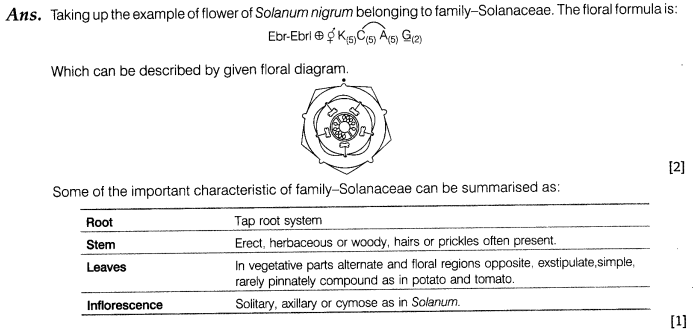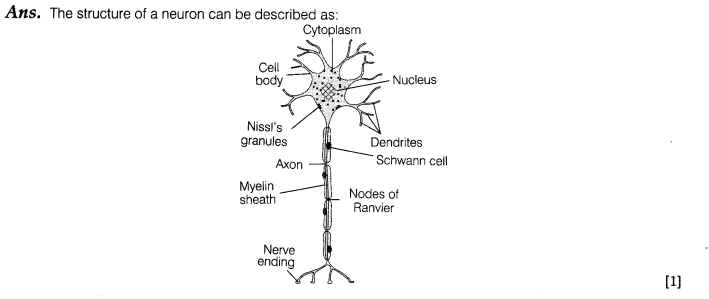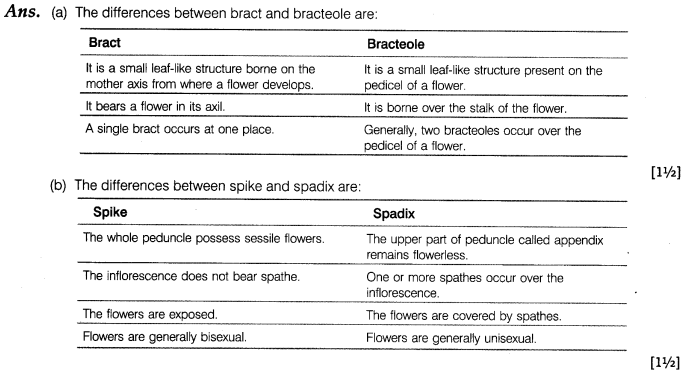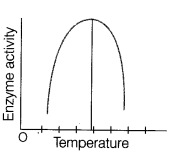CBSE Sample Papers for Class 11 Biology Solved Set 2
Section A
1. Name the reserve food material in Phaeophyceae group of algae.
2. Inulin is a homopolysaccharide found in plants. What is the basic monomeric unit of this polymer?
3. We can observe different eye colours, i.e. green, brown or black among ourselves. Name the pigment responsible for colour of eyes.
4. Name the epithelial tissues present on the inner surface of bronchioles and Fallopian tubes.
5. Think of a plant which lacks chlorophyll. From where will it obtain nutrition? Give an example of such a type of plant.
section B
6. The cell cycle comprises of a long interphase and short dividing phase. What is the significance of G0-phase in cell cycle?
7. What conditions enable RuBisCO to function as an oxygenase? Explain the ensuring process.
8. Marine mammals are able to make long underwater dives. Justify the statement.
9. What is mesosome in a prokaryotic cell? Mention the function that it performs.
or
Name the types of joint present between(a) Atlas and axis (b) Phalanges
(c) Femur and acetabulum (d) Cranial bones
Section C
10. Write down the major characteristics of family-Solanaceae. Also, mention the floral formula and floral diagram of a flower belonging to this family.
11. What do you understand by ‘algal bloom’ and ‘ red tides’? How are they harmful for the environment?
12. (a) Differentiate between saturated and unsaturated fatty acids.
(b) What is cholesterol? Describe the two forms of cholesterol.
13. What are the main steps in aerobic respiration? Where does it take place?
14. How is cephalisation in animals considered as an asset in an adjustment with the environment?
15. Both lysosomes and vacuoles are a part of endomembrane structures, yet they differ in their functions. Comment.
16. When a freshly collected Spirogyrafilament is kept in a 10% potassium nitrate solution, it is observed that the protoplasm shrinks in size.
(a) What is this phenomenon called?
(b) What will happen if the filament is replaced in distilled water?
17. Differentiate between florigen and other growth hormones.
18. Describe the structure of a neuron with the help of a labelled diagram. Give an account of types of neuron based on structure.
19. Differentiate between
(a) Bract and bracteole (b) Spike and spadix
or
Name the structures forming the female reproductive part in flowering plants. Discuss the structures and state how placenta is related to this part. State the types of placentation found.
20. Name the hormones regulating the following.
(i) Control of skin colour (ii) Release of sugar from liver
(iii) Widening of pelvis at birth
Also mention from where these hormones are secreted.
21. Sneha’s mother while leaving in a hurry instructed her to keep the tomatoes and other fruits, e.g. apples and grapes inside the refrigerator. Sneha was busy preparing for her exams and forgot to keep them inside. When her mother came after two days, she observed them rotting in the kitchen and reminded Sneha of the instructions. She wondered how did they get spoilt in a day whereas we use them fresh for longer periods usually. To this, Sneha’s elder sister , a student of biology explained her the reason.
(a) How does the shelf life of fruits and vegetables increase in a refrigerator?
(b) Describe the influence of temperature on enzyme action through a graphical representation.
(c) Do you think, there might be some other factors that influence its action?
(d) What values are reflected by Sneha and her elder sister?
Section D
22. Terrestrial animals are generally either ureotelic or uricotelic not ammonotelic. Why?
or
Explain the mechanism of vision, i.e. image formation by human eye.
23. Plant hormones known for their various physiological functions may act synergistically or antagonistically. Give reasons in support of this statement.
or
Deciduous plants shed their leaves during hot summer or in autumn. This process of shedding of leaves is called abscission. Apart from physiological changes, what anatomical mechanism is involved in the abscission of leaves?
Answers
Section A
1. Name the reserve food material in Phaeophyceae group of algae. [1]
Ans. The reserve food material in Phaeophyceae or brown algae is laminarin or mannitol.
2. Inulin is a homopolysaccharide found in plants. What is the basic monomeric unit of this polymer? [1]
Ans. Inulin is a homopolysaccharide, made up of polymers of fructose.
3. We can observe different eye colours, i.e. green, brown or black among ourselves. Name the pigment responsible for colour of eyes.[1]
Ans. Iris that forms a pigmented circle of muscular diaphragm gives eye its varied colours in different individuals.
4. Name the epithelial tissues present on the inner surface of bronchioles and Fallopian tubes. [1]
Ans. Ciliated columnar epithelium is present on the inner surface of bronchioles, Fallopian tubes, respiratory tract, ventricles of brain, etc.
5. Think of a plant which lacks chlorophyll. From where will it obtain nutrition? Give an example of such a type of plant.[1]
Ans. An angiospermic plant called Monotrapa do not contain chlorophyll. It grows on some other plant as a parasite and derive nutrition from the host plant. This plant is commonly known as ghost plant,
Section B
6. The cell cycle comprises of a long interphase and short dividing phase. What is the significance of G0-phase in cell cycle? [2]
Ans. G0-phase is the extension ofGrphase and is also known as the quiescent stage of the cell cycle. Cells in this stage remain metabolically active and function as reserve cells, but no longer proliferate unless called on to do so depending on the requirement of the organisms.
7. What conditions enable RuBisCO to function as an oxygenase? Explain the ensuring process. [2]
Ans. Carboxylation is the most crucial step of the Calvin cycle, where C02 is utilised for the carboxylation of RuBP. This reaction is catalysed by the enzyme RuBP carboxylase which results in the formation of two molecules of 3-PGA. Since, this enzyme also has affinity for oxygen, it shows oxygenation activity when the CO2 concentration decreases. During high temperature the RuBP binds to 02 and acts as oxygenase enzyme, which forces C02 to enter C2 cycle thus leading to photorespiration and loss of C02.
8. Marine mammals are able to make long underwater dives. Justify the statement.[2]
Ans. Marine mammals like whales, seals, etc, are able to make long underwater dives because they have large spleen with blood and can store more oxygen in blood and muscles. They are also able to reduce oxygen consumption rate, when underwater thus enabling them to survive longer there.
9. What is mesosome in a prokaryotic cell? Mention the function that it performs.
or
Name the types of joint present between[1 +1]
(a) Atlas and axis (b) Phalanges
(c) Femur and acetabulum (d) Cranial bones
Ans. Mesosome is a special membrane structure which is formed by the extension of the plasma membrane into the cell in a prokaryotic cell. It helps in cell wall formation, DNA replication and distribution of genetic material to daughter cells. It also helps in respiration, secretion processes to increase the surface area of the plasma membrane and enzymatic content.
or
The type of joints present between
(a) Atlas and axis is pivot joint.
(b) Phalanges is hinge joint.
(c) Femur and acetabulum is ball and socket joint.
(d) Cranial bones is suture (fibrous joint).
Section C
10. Write down the major characteristics of family-Solanaceae. Also, mention the floral formula and floral diagram of a flower belonging to this family.
11. What do you understand by ‘algal bloom’ and ‘ red tides’? How are they harmful for the environment?
Ans. Sometimes, green algae such as Chlorella, Scenedesmus and Spirogyra, etc., grow in excess in water bodies and impart green colour to the water. These are called algal blooms. Red dinoflagellates (Gonyaulax)’grow in abundance in sea and impart red colour to the ocean. This looks like red tides. Due to algal blooms and red tide, the animal life declines as these makes toxins and deficiency of oxygen inside water.
12. (a) Differentiate between saturated and unsaturated fatty acids.
(b) What is cholesterol? Describe the two forms of cholesterol.
(b) Cholesterol is a common sterol found in animals and humans. Its molecular formula is C27H45 It occurs in both free and combined form when esterified with a fatty acid. It acts as a precursor of most steroid hormones.
Cholesterol exists in two forms:
(i) LDL (Low Density Lipoprotein) It can be small and dense or large and buoyant particles. It is known as bad cholesterol and is harmful since LDL can enter arterial walls and makes the blood sticky or clot.
(ii) HDL (High Density Lipoprotein) It is also known as good cholesterol. It is dense and removes scavenges LDL from the blood to liver, thus reducing the risk of heart disease.
13. What are the main steps in aerobic respiration? Where does it take place?[3]
Ans. The main steps in aerobic respiration are as follows:
(i) Glycolytic breakdown of glucose into pyruvic acid. It takes place in cytoplasm.
(ii) Oxidative decarboxylation of pyruvic acid to acetyl Co-A (acetyl coenzyme-A)
(iii) Krebs’ cycle. It occurs in mitochondrial matrix.
(iv) Terminal oxidation and phosphorylation in respiratory chain.
It occurs in the inner mitochondrial membrane.
14. How is cephalisation in animals considered as an asset in an adjustment with the environment? [3]
Ans. The animals having bilateral symmetry move with their anterior end forward. This has led to cephalisation, i.e. differentiation of a definite head at the anterior end. Cephalisation involves the concentration of nervous tissue (brain) and sense organs in the head. This arrangement is an asset in an adjustment with the environment, as the anterior end of a moving animal is the first to encounter changes in the area of its entering.
15. Both lysosomes and vacuoles are a part of endomembrane structures, yet they differ in their functions. Comment.[3]
Ans. Endomembrane system is an intracellular membrane system which is connected by flow of membranes and substances from one region to another with the aid of vesicles. It is formed by grouping of some membrane organelles that function in close coordination with one another, e.g. endoplasmic reticulum, Golgi complex, lysosomes and vacuoles.
However, each of the components are specialised to perform distinct functions. Such as, lysosomes are specialised for intracellular digestion as well as extracellular digestion. Besides this, it also shows autophagy and intracellular scavenging. Vacuoles on the other hand are meant for either storage of substances, osmoregulation or maintaining buoyancy.
16. When a freshly collected Spirogyrafilament is kept in a 10% potassium nitrate solution, it is observed that the protoplasm shrinks in size.
(a) What is this phenomenon called?
(b) What will happen if the filament is replaced in distilled water?
Ans. (a) Plasmolysis is the phenomenon occurring in Spirogyra filament when placed in 10% potassium nitrate solution(hypertonic solution). It occurs as water from the cell is drawn out to extracellular fluid causing the protoplast to shrink away from cell wall.
(b) When the above Spirogyra is placed in distilled water, it will again reabsorb water, protoplast will again come back in its original shape. This phenomenon is known as deplasmolysis.
17. Differentiate between florigen and other growth hormones.
18. Describe the structure of a neuron with the help of a labelled diagram. Give an account of types of neuron based on structure.
On the basis of structure, neurons can be classified as:
(a) Non-polar neurons possess several branched processes.
(b) Unipolar neurons possess single projection arising from cyton.
(c) Pseudounipolar neurons possess single process arising from cyton but divides into an axon and a dendrite.
(d) Bipolar neurons have two processes with axon at one end and dendrite at another end.
(e) Multipolar neurons possess several dendrites and an axon, and are the most common type of neurons.
19. Differentiate between
(a) Bract and bracteole (b) Spike and spadix
or
Name the structures forming the female reproductive part in flowering plants. Discuss the structures and state how placenta is related to this part. State the types of placentation found.
or
Gynoecium forms the female reproductive part of flower. It comprises of one or more carpels or pistils. The individual carpel consists of three parts:
Stigma is the tip of the carpel and acts as a receptive surface for pollen grain.
Style is tube like structure connecting ovary to stigma.
Ovary is the basal enlarged part. Each ovary bears one or more ovules attached to flattened cushion-like placenta.The arrangement of ovules inside a ovary is called placentation. It may be of following types:
20. Name the hormones regulating the following.
(i) Control of skin colour (ii) Release of sugar from liver
(iii) Widening of pelvis at birth
Also mention from where these hormones are secreted.[1 x 3]
Ans. The hormones controlling or regulating the
(i) Skin colour is MSH (Melanocyte Stimulating Hormone). It is secreted by the intermediate lobe of pituitary.
(ii) Release of sugar from liver is regulated by glucagon. It is secreted by a-cells of islets of Langerhans (pancreas).
(iii) Widening of pelvis at birth is regulated by oxytocin.lt induces contraction of smooth muscles of uterus during parturition. It is secreted originally by neurosecretory cells in hypothalamus but are stored and released from posterior lobe of pituitary gland.
21. Sneha’s mother while leaving in a hurry instructed her to keep the tomatoes and other fruits, e.g. apples and grapes inside the refrigerator. Sneha was busy preparing for her exams and forgot to keep them inside. When her mother came after two days, she observed them rotting in the kitchen and reminded Sneha of the instructions. She wondered how did they get spoilt in a day whereas we use them fresh for longer periods usually. To this, Sneha’s elder sister , a student of biology explained her the reason.
(a) How does the shelf life of fruits and vegetables increase in a refrigerator?
(b) Describe the influence of temperature on enzyme action through a graphical representation.
(c) Do you think, there might be some other factors that influence its action?
(d) What values are reflected by Sneha and her elder sister?
Ans.
(a) Food when kept inside a refrigerator is prevented from spoiling both by microorganisms and its own enzymes (present in living cells). Since refrigerator maintains low temperature, the enzymes remain inactive and don’t act upon complex substrates converting them into simpler forms, thus preventing degradation.
(b) The activity of enzymes decreases at both high and very low temperatures but is maximum at optimum temperatures.
(c) The other factors that affect the enzyme activity are pH, concentration of substrate and presence of inhibitors, if any.
(d) Sneha is curious with a quest to learn but a little careless. While Sneha’s sister being elder to her is more mature, attentive and had a better understanding of the subject along with its practical application. So, she seems intelligent as well.
Section D
22. Terrestrial animals are generally either ureotelic or uricotelic not ammonotelic. Why?[5]
or
Explain the mechanism of vision, i.e. image formation by human eye.[5]
Ans. Terrestrial adaptation requires the production of lesser toxic nitrogenous wastes like urea and uric acid for the conservation of water. Mammals, many terrestrial amphibians and marine fishes mainly excrete urea and are called ureotelic animals. Ammonia produced by metabolism is converted into urea in the liver of these animals and released into the blood which is filtrated and excreted out by the kidneys.
Some amount of urea may be retained in the kidney matrix of some of these animals to maintain a desired osmolarity. Reptiles, birds, land snails and insects excrete nitrogenous wastes as uric acid in the form of pellet or paste with a minimum loss of water and are called uricotelic animals.
or
The mechanism of image formation on the retina of human eye is as follows:
(i) Retina receives light rays (in visible wavelength) through the cornea and lens generate impulses in rods and cones.
(ii) The photosensitive compounds (photopigments) in the human eye are composed of opsin (a protein) and retinal (an aldehyde of vitamin-A).
(iii) The received light induces dissociation of the retinal from opsin resulting in changes in the structures of the opsin. This causes the changes in the permeability of membrane.
As a result, the potential difference is generated in the photoreceptor cells. This produces a signal that generates action potential in the ganglion cells through the bipolar cells.
(iv) These impulses (action potentials) are transmitted by the optic nerves to the visual cortex of the brain.
(v) In brain, neural impulses are analysed and the image formed on the retina is recognised (based on earlier memory and experience).
23. Plant hormones known for their various physiological functions may act synergistically or antagonistically. Give reasons in support of this statement. [5] or
Deciduous plants shed their leaves during hot summer or in autumn. This process of shedding of leaves is called abscission. Apart from physiological changes, what anatomical mechanism is involved in the abscission of leaves?[5]
Ans. The evidences that support phytohormones act synergistically or antagonistically are:
(i) Cell division is promoted by both auxins and cytokinins acting synergistically.
(ii) Auxin and cytokinins interact to control morphogenetic differentiation of shoot and root. When auxin is in excess, roots differentiate on the callus, while excess of cytokinins promote bud formation.
(iii) Auxins and cytokinins acts antagonistically in controlling apical dominance. Auxins causes apical dominance, while cytokinins overcome the same.
(iv) Senescence is prevented by auxins and cytokinins, while it is stimulated by abscisic acid.
(v) The activity of cambium and fruit growth seem to be promoted by auxins, gibberellins and cytokinins, the same is inhibited by abscisic acid.
(vi) The dormancy of seeds and buds is mostly due to abscisic acid, the same is broken by gibberellins.
(vii) Cytokinins cause opening of stomata, while abscisic results in their closure.
or
The process of shedding of leaves during hot summer or in autumn by deciduous plants is known as abscission. Anatomically, the cells of abscission zone are thin-walled and without deposition of lignin or suberin. At the time of abscission, the middle lamella may dissolve between the cells of two middle layers but the primary wall remain intact. The middle lamella as well as the primary walls of the adjacent cells is dissolved. Ultimately, all the cells of middle layer found in the abscission layer gets dissolved completely. Thus, there is separation of plant organ, i.e, leaf from the plant, wherever there is rainfall or wind.